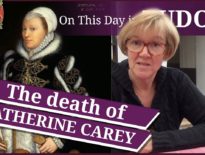On this day in Tudor history, 14th January 1589, physician Francis Kett, was burned for heresy near Norwich Castle.
A local minister described him as "leaping and dancing" in the fire, clapping his hand and praising God right up to the end. A courageous man.
But how did Francis Kett come to this awful end?
Find out more about this doctor, priest and condemned heretic in today's talk.
You can read the charges laid against Francis Kett at https://sourcetext.files.wordpress.com/2017/12/greene_01.pdf - appendix B, p. 259.
Also on this day in Tudor history, 14th January 1559, Queen Elizabeth I left the Tower for her eve of coronation procession through the streets of London. Here's a link to last year’s talk on her coronation procession and all the pageants and celebrations that were part of it:
Also on this day in history:
- 1478 – Birth of Henry Algernon Percy, 5th Earl of Northumberland. He was the eldest son of Henry Percy, 4th Earl of Northumberland, and Maud Herbert, daughter of William Herbert, 1st Earl of Pembroke.
- 1515 – Charles Brandon, Duke of Suffolk, was sent to France to bring back Henry VIII's sister, Mary Tudor, Queen of France.
- 1526 – Francis I and Charles V signed the Treaty of Madrid. Francis I had been captured at the Battle of Pavia, and was held until this treaty was concluded. By the terms of the treaty, Francis renounced his claims to lands in Italy, Flanders, Artois and Tournai. Once he was released and back in France, Francis refused to ratify the treaty.
Transcript:
On this day in Tudor history, 14th January 1589, physician Francis Kett, was burned for heresy near Norwich Castle.
Francis Kett was born in or around 1547 in Wymondham in Norfolk, East Anglia, and was the nephew of Robert Kett, leader of the famous Kett’s Rebellion in Norfolk in the reign of Edward VI. Francis was educated at Clare College and Corpus Christi College, Cambridge, attaining his BA and MA in 1570 and 1573 respectively. He became a fellow of Corpus Christi in 1573 and was also ordained as a priest. He graduated MD in 1581 and in 1585 he published his work “The Glorious and Beautiful Garland of Mans Glorification”, which he dedicated to Queen Elizabeth I. In the same year, he published “An epistle to divers papistes in England, proving the Pope to be the beast in the XIII Revelations, and to be the man exalted in the temple of God, as God, (2 Thess II. 4) whereby the true Christ is knowen from the evil”.
Three years later, in 1588, Edmund Scambler, Bishop of Norwich, brought Articles of heretical pravity against Francis. On 7th October 1588, the bishop wrote to William Cecil, Lord Burghley, telling him that he had “lately condemned for heresy Francis Ket, M. A. whose blasphemous opinions he had thought good to acquaint his honour with; and referring to his wisdom the speedy execution of, he being so dangerous a person.” According to the articles brought by the Bishop of Norwich, Kett was accused of believing:
• That the new Covenant promised is not yet established, and that the Covenant, which you mean, is the Lawe of God written in our hearts and the forgiveness of our sinnes.
• That there is no sufficient sacrifice past for the sinnes of the worlde, but that Christ shall offer it at the ende of the worlde.
• That the Christ hath suffered only as Jesus allready and shall suffer hereafter as Jesus Chryste. That Chryste is now in his human nature gathering a church here in earth in Judea.
• That this yeare of our Lord 1588 divers and Jewes shall be sent into dyvers countryes to publishe the new covenant.
• That Chryste shall againe suffer and gyve his soule for the synne of the worlde before the last daye.
• That Chryste shall comme before the ende of the world, before the last daye.
There was a further list of “blasphemous heresies of one Kett” which I’ll give you a link to read.
William Burton, a minister in Norwich, also recorded that Francis believed that “Christ is not God, but a good man as others be”. Burton did, however, add that Francis’s tongue never ceased praising God, that he was always in prayer, and that “The sacred Bible almost never out of his hands”.
On this day in history, 14th January 1589, Francis Kett was taken to the ditch of Norwich Castle to be burned at the stake. The minister William Burton recorded that “when he went to the fire he was clothed in sackecloth, he went leaping and dauncing: being in the fire, above twenty times together clapping his hands, he cried nothing but blessed bee God … and so continued until the fire had consumed all his nether partes, and untill he was stifled with the smoke.”
Poor Kett.



Leave a Reply